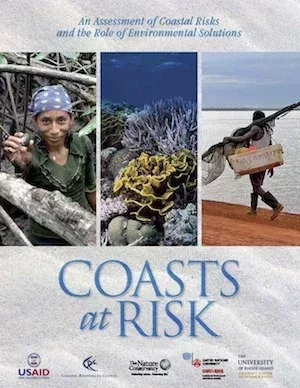Tropical and small island developing States (SIDS) are most at risk from exposure and vulnerability to coastal hazards, according to ‘Coasts at Risk: An Assessment of Coastal Risks and the Role of Environmental Solutions.’ The report uses an indicator-based approach to assess risks from exposure and vulnerability to coastal hazards and identifies where environmental degradation increases these risks. The report then considers how environmental solutions, such as conservation and restoration, can contribute to risk reduction and conservation goals.
The Coasts at Risk (C@R) Index builds on the methodology and framework of the World Risk Report, which found that “coastal countries were consistently at the greatest risk” across all countries and hazards. The C@R Index considers exposure, susceptibility, coping capacity and adaptive capacity and includes indicators on coastal habitats and fisheries. The index identifies the top ten coastal countries with the highest risk: Antigua and Barbuda; Tonga; Saint Kitts and Nevis; Vanuatu; Fiji; Brunei Darussalam; Bangladesh; the Philippines; Seychelles; and Kiribati.
The report includes chapters on coral reefs, fisheries and mangrove forests that examine how environmental degradation of these resources and climate change contribute to risk, and how conservation and habitat restoration can reduce risk. Improved understanding of the links between fisheries and food security is necessary to identify focus areas for conservation, according to the report. It recommends fisheries management and research to address social vulnerability. It advocates for coral reef and mangrove restoration as cost-effective risk reduction options, particularly in coastal, tropical countries that face the greatest risk from natural hazards.
Report recommendations, which focus on adaptation, conservation and risk reduction, call for, inter alia: focusing marine conservation efforts in areas with high population density, rather than in remote areas; increasing risk prevention measures and opportunities for improved post-disaster development choices; targeting research on environmental risk reduction; and developing integrated risk assessments that account for drivers of risk, such as environmental degradation. It also recommends: rigorous accounting for ecosystem services and sustainable investments in natural infrastructure.
The UN University Institute for Environment and Human Security (UNU-EHS), The Nature Conservancy (TNC) and the Coastal Resources Center at the University of Rhode Island Graduate School of Oceanography collaborated on the publication. The US Agency for International Development (USAID), the Pew Marine Fellowship Program and the Lyda Hill Foundation provided support for the publication.
Source: Biodiversity Policy & Practice
